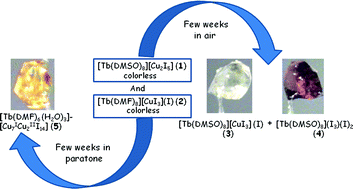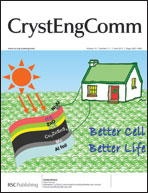Solid-state structural transformations in metal organic-inorganic hybrids constructed from terbium(iii) complexes and iodocuprate clusters†
Abstract
Using precursors of the type [Tb(DMSO)8]I3 (a) and [Tb(DMF)8]I3 (b), syntheses of two new heterometal organic–inorganic hybrid complexes based on discrete iodocuprate clusters [Tb(DMSO)8][Cu2I5] (1) and [Tb(DMF)8][CuI3][I] (2), respectively, are reported. Though stable in air for few days, the colorless complex 1 slowly turns into a purple-colored mixture over the course of several days. Two complexes, namely [Tb(DMSO)8][CuI3][I] (3) and [Tb(DMSO)8](I)2(I3) (4), were isolated from this mixture and characterized structurally, the I3− anion in latter being responsible for the purple color of this mixture. In comparison, complex 2 is quite deliquescent in air but undergoes solid state structural transformation in a confined environment of paratone to afford a 2D honeycomb-like microporous structure containing mixed-valent


 Please wait while we load your content...
Please wait while we load your content...